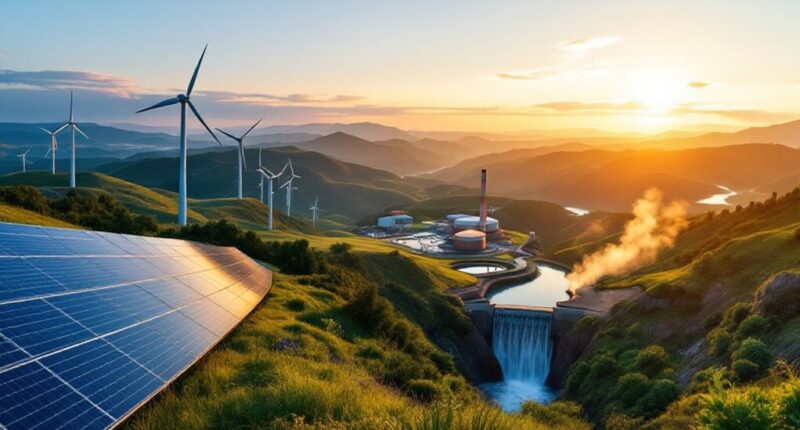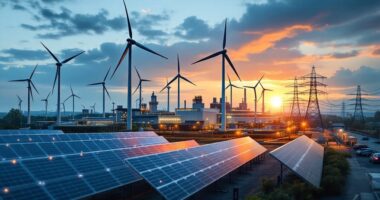Renewable energy harnesses natural, replenishing resources to power our world cleanly. Solar panels capture sunshine, wind turbines spin in the breeze, while hydropower, geothermal, and biomass round out the green portfolio. These technologies offer substantial environmental benefits and economic opportunities, though they face challenges like intermittency and outdated grid infrastructure. As technology advances, costs drop while efficiency rises—making these sustainable options increasingly competitive with fossil fuels. The shift continues to accelerate in exciting ways.

The dawn of a new energy era is breaking across the horizon, bringing with it the promise of cleaner, more sustainable power sources. Renewable energy—drawn from naturally replenishing resources that refresh themselves faster than we can deplete them—has moved from fringe alternative to mainstream contender in our global energy mix.
Like nature’s own subscription service, these energy sources deliver power without the “sorry, we’re out of stock” messages that fossil fuels will eventually send.
Today’s renewable landscape features a cast of eco-celebrities: solar panels basking in the spotlight, wind turbines pirouetting across plains and coastlines, hydropower dams doing the heavy lifting, geothermal wells tapping Earth’s core like it’s a natural hot water bottle, and biomass converting yesterday’s organic leftovers into tomorrow’s electricity.
Together, they’re already generating 20% of America’s electricity—not bad for the new kids on the grid.
The environmental perks of renewables read like a planetary wish list: slashed carbon emissions, cleaner air that lungs everywhere are thanking us for, water conservation, and ecosystem preservation.
Switching to renewables is like giving Earth a wellness plan after centuries of environmental junk food.
It’s like giving Mother Nature a spa day after two centuries of industrial stress. Economically, renewables are job-creating machines, spawning new industries faster than you can say “solar installer.”
While initial costs might make your wallet wince, the long-term savings could have you grinning all the way to energy independence. In 2023 alone, global renewable power capacity grew by an impressive 473 gigawatts, demonstrating the accelerating pace of clean energy adoption worldwide.
Technology in this sector is evolving faster than smartphone models. Solar panels are becoming more efficient than your most productive coworker, and energy storage solutions are finally addressing the “what happens when the sun takes a nap?” problem. Modern courses now emphasize the importance of energy storage technologies including pumped hydro, batteries, and hydrogen as critical components of reliable renewable energy systems.
But challenges persist like uninvited party guests—intermittency issues, geographic limitations (good luck with solar in Seattle), and grid infrastructure that sometimes feels like trying to run modern software on a 1990s computer.
Globally, renewable capacity is multiplying while costs plummet, painting a future where clean energy isn’t just the righteous choice—it’s the economical one. Embracing policy incentives can accelerate the transition from carbon-intensive energy sources to renewable alternatives, creating a more sustainable energy landscape.
The renewable revolution isn’t just coming; it’s already plugged in and powering up.
Frequently Asked Questions
How Quickly Can Countries Transition to 100% Renewable Energy?
Countries can shift to 100% renewable energy remarkably quickly when conditions align. Evidence shows shifts ranging from 5 years (Uruguay increased wind from 1% to 34%) to about 20 years.
Success factors include strong government policies, abundant natural resources, economic incentives, and falling technology costs.
However, most nations face significant challenges with grid infrastructure, energy storage, and political resistance that extend shift timelines to 20-30 years for thorough implementation.
Which Countries Lead the World in Renewable Energy Adoption?
China dominates renewable energy adoption, contributing 66% of global deployment with 373.6 GW added in 2024.
The United States follows with 45.9 GW, bolstered by IRA incentives, while the European Union added 70.1 GW, doubling its pre-crisis growth.
India aims for 500 GW non-fossil capacity by 2030.
Costa Rica stands out among smaller nations, maintaining 98% renewable electricity for over eight years—proving size isn’t everything in the green energy race.
Can Renewable Energy Create More Jobs Than Fossil Fuels?
Evidence suggests renewable energy creates more jobs than fossil fuels. The data shows renewable energy generates three times more jobs per $1 million invested, with global renewable jobs reaching 16.2 million in 2023—more than doubling since 2012.
Clean energy employment grew at twice the rate of overall U.S. job growth last year. However, challenges exist in translating fossil fuel job losses to renewable gains due to geographic mismatches and skills gaps.
How Do Renewable Energy Costs Compare Across Different Regions?
Renewable energy costs vary dramatically across regions due to several factors.
China leads with the lowest solar and wind prices globally, while European countries like Sweden demonstrate how high renewable penetration can coexist with low electricity costs.
In the U.S., there’s no clear correlation between renewable adoption and electricity prices.
Local resources, infrastructure, policies, market structures, and deployment scale all influence regional cost differences more than the technology choice itself.
What Skills Are Needed for Careers in Renewable Energy?
Careers in renewable energy demand a diverse skill set.
Professionals need technical expertise in electrical systems and renewable technologies, along with proficiency in data analysis and CAD modeling.
Equally important are soft skills like communication and adaptability.
Educational backgrounds in STEM fields provide the foundation, while industry-specific competencies such as safety protocol compliance and energy auditing round out the profile.
Environmental commitment and continuous learning remain essential as the field rapidly evolves.









